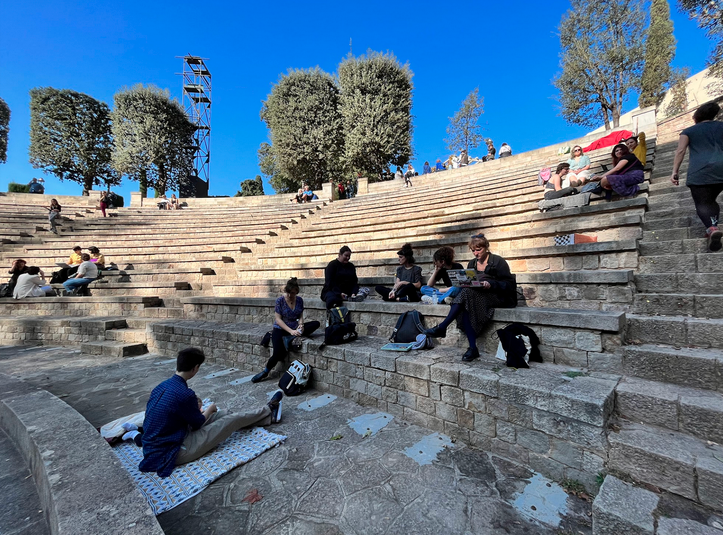Key Elements for Funders to Build a Culture of Crisis Preparedness
Written by Cath Thompson, Peace and Security Funders Group, and Soheila Comninos, Open Society Foundations
Regardless of where you sit in the funding ecosystem, you have most likely faced funding in crisis. From wars to natural disasters to attacks on human rights defenders, most of us will find ourselves at the intersection of the issue(s) we care about and a crisis (e.g., environmental disaster, conflict, acute violence, pandemic) at some point. As we face a wave of intersecting crises, the philanthropic sector must invest now in building a culture of preparedness. Doing so will allow us to proactively anticipate and be ready for changes – both positive and negative – which will put us in a better position to protect lives and safeguard good work. We know we need crisis preparedness strategies, but what does this look like? Where do we begin?
Building a culture of preparedness requires three major types of investments: (1) in our own internal foundation capacity, (2) in our grantee partners and relationships with other networks, and (3) in field-wide resilience and advocacy. Building a culture of preparedness also involves taking into account the entire life cycle of a crisis, anticipating needs and seizing openings before crisis, during active response, and over long-term reconstruction and resilience. Beyond technical solutions, we must especially think in terms of networks and relationships, with special consideration to those most affected who should be centered during crisis response.
During a session at the Human Rights Funders Network’s (HRFN) recent conference in Oaxaca, Mexico, the Peace and Security Funders Group (PSFG), the Open Society Foundations and Global Fund for Women co-organized a conversation on crisis preparedness strategies for funders. The conversation was intentionally broad to include a range of perspectives. Participants from private foundations, intermediary funders, and rapid-response practitioners crowdsourced what works in crisis preparedness and response; what has been helpful to funders in their experience of crises; and the gaps we need to address. We attempt to synthesize this conversation below, lifting up the major themes that emerged out of the brainstorm. This is not an exhaustive list, but by highlighting some of the key elements of crisis preparedness frameworks, we hope that it might serve as a starting point for further conversation.
Internal Foundation Capacity and Practice
Invest in local relationships and expertise
One of the most vital themes that arose in the workshop was the need to build existing relationships with movements, activists, and local leaders well before any crisis. This idea reflects ongoing conversations that funders of locally-led peacebuilding and community-based groups have been shepherding for several years, and it is reassuring that these themes permeate across issue areas. Receiving direction from local communities, rather than what is in the media or donors’ priorities, will allow your crisis response to be most relevant to true needs. Ideally, foundations would hire human rights activists and peacebuilders on staff. But, because not every foundation can hire in-country staff, having a roster of local consultants and trusted relationships with human rights defenders and peacebuilders who have intimate knowledge of the political, cultural, and economic context is an essential condition for swift and effective action. Do not call upon these local experts without attending to potential risks to them and do compensate them for their time and expertise when you ask for it.
Study the context and develop a preparedness plan
No funder wants to be stuck cramming to learn all about a context when the pressure is on to distribute funds. Participants at our session recommended spending time to educate oneself, build relationships, and invest in capacity in anticipation of a crisis. Establish an action plan, including knowing everyone’s roles and responsibilities ahead of a crisis, completing risk assessments (e.g., political, geological, financial) for the contexts where you work, and conducting scenario planning exercises and even drills. Share assessments and scenarios with other funders, both to build efficiency and to reduce the burden on local experts who may be asked for their insight by multiple funders. When a crisis strikes, develop plausible scenarios, jointly with other funders and actors, and think through the implications and possible actions. Spending the time to prepare, learn, and build relationships should not be a luxury when all your other tasks are finished. Rather, it is critical to any good crisis preparedness plan.
Reduce bureaucracy internally
When hours and days may mean life or death, funders who have established flexible and efficient processes well in advance of a crisis can save lives. During the height of the COVID-19 pandemic, for example, many funders chose to do away with onerous proposal and reporting requirements, only asking for the bare minimum and trusting grantee partners to use funds as needed, including allowing them to reallocate funds, should they choose. Establish quick board or executive approval processes and make requesting and reporting simple and culturally responsive.
Know when not to intervene
Interestingly, we heard several calls for funders to step back when they may not be the best-placed actor to respond. Don’t just jump in on the headlines. It takes humility and a collaborative spirit to hold back when you realize that your intervention may cause more burden to those actively managing a conflict or crisis. Perhaps this means moving funding to an intermediary instead of building new partnerships from the ground up. Funders simply cannot respond to all the needs that will come up, so foundation staff must come to internal clarity on the boundaries of their actions. Also, understand the limits of your internal capacity. As one participant put it: “Know what you actually do across your organization. Don’t create myths.” Corollary to this is to be mindful of your own staff’s burnout levels and staff appropriately in anticipation of crisis moments.
External Support for Grantee Partners
Integrate local movements in defining the work
Funders should seek out (and compensate!) the expertise of local human rights defenders and activists, peacebuilders, and other grantee partners to know what response or actions are best, taking a strong intersectional lens to be able to understand the nuances of community needs. Try to integrate many perspectives, including accessibility needs. Draw on existing grantee partners and relationships, take your lead from the communities and movements who are most impacted, and understand your place in the ecosystem of crisis response. The Feminist Alchemy collective, hosted at Global Fund for Women, is an example of funders working together to understand needs in holistic ways and take a feminist approach to response. As they say: “Building a strong network is key to feminist crisis preparedness as we continuously analyze the social, political, and cultural context, understanding it from our partner’s perspective, having a deep sense of the oppressive systems that perpetuate injustices and doing our analysis through an intersectional lens.” When funders collaborate, it helps bring together various local insights and contribute to a more comprehensive picture of the context and needs.
Think expansively about money
We must think of funding in new ways when it comes to crisis preparedness and response, given that formal banking systems are often disrupted during a crisis. You might consider providing “safety net” funding to partners in anticipation of crises, pre-positioning money on the ground, or – at a minimum – providing flexible, unrestricted, multi-year funding. Foundations can set aside institution-wide “crisis funds” for different geographies/contexts and allow for internal budget wiggle room. Funders can also support financial capacity-building for grantees to be able to manage and safeguard the funds they receive.
Support accompaniment in the full arc of need
Beyond money, funders can set up systems for evacuation, transportation, and visa application support. Accompaniment should follow the entire arc of a partner’s need and that of their family, even beyond relocation, if necessary. Support for wellbeing, mental health, psychosocial support, and collective care are necessary parts of a good strategy and can and should be established before a crisis happens.
Invest in networks, networks, networks
We heard time and time again that networks are the key to accomplishing anything in crisis, because collaboration and information-sharing allow for stronger and more efficient outcomes. But networks don’t just happen; they require investment and intentionality, ideally before any crisis. Be willing to share information (e.g., embassy contacts, safe houses), funding structures (e.g., rapid response funds and long-term support), and support existing community networks (e.g., around security response). This is also where funder affinity groups like PSFG and HRFN are critical to establishing trusted relationships between funders, allowing peers to activate these networks quickly during a crisis. Be proactive in your coordination with other donors and stakeholders (e.g. governments, bilateral and multilateral aid agencies, humanitarian and development actors) and strive to break silos, knowing that you are an important node between need and response. Global Fund for Women’s Sandra Macías del Villar explained the importance of networks vis-a-vis the Feminist Alchemy collective, which she coordinates. “Every member within our network contributes in their own capacity within their context and based on expertise, making the response powerful and diverse. Our strength is in the ‘how’ and the ways we practice feminist crisis response. We truly believe not only in collective organizing, but in learning from each other and supporting each other, to strengthen our responses during crises.”
Field-wide Action and Advocacy
Take advantage of advocacy capacity
Funders exist in the relative safety and power of the philanthropic sector, so it’s incumbent on us to advocate for tackling the systemic issues that caused the crisis in the first place and for addressing issues that hinder its resolution. Coordinated advocacy efforts are stronger than individual organizations acting alone. Participants in the session cited the importance of funder advocacy around legal or administrative harassment, including misuse or abuse of laws to shutter civil society organizations. They also suggested funders build strong partnerships with the United Nations, governments, and media allies, all of whom can be called upon at key moments during a crisis.
Coordinate the philanthropic ecosystem
Participants cited the need for transparency around who is funding what and better coordinated efforts across the philanthropic ecosystem itself. Oftentimes we simply don’t know what others are funding, which can result in duplication of efforts and create competition for resources for partners. HRFN’s Advancing Human Rights research and PSFG’s Peace and Security Funding Map are two resources that shed light on funding in these areas. Pooled funding can be a powerful tool for making all of our resources go further. Funders can also use their place in the ecosystem to advocate to their fellow donors on best practices including flexible, long-term, core funding and getting out of their funding siloes.
Pay attention to signals
Foresight, forecasting, early warning, and scenario planning tools are central to crisis preparedness. Several participants noted that the signals of an emerging crisis can be seen well in advance, so it is important to pay attention to indicators and triggers such as upcoming elections, political instability and social unrest, increasing repressive security laws or criminal codes, and who is being targeted. Risk assessments can bring some of these signals to light, as can regular knowledge-sharing with trusted networks and peer funders. Funders would greatly benefit from learning about these tools and integrating them in their strategies and daily work.
What would you add to this list of essential elements of crisis preparedness strategies? This list is certainly incomplete and deserves much more discussion. We hope the above ideas can spark deeper conversations (and networks!) around crisis preparedness, and we look forward to learning more from emergent communities of practice.



